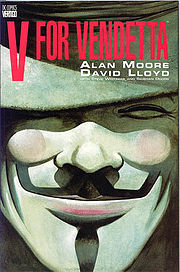Ben Saunders left this comment in response to Isaac Butler’s V for Vendetta piece.
Fascinating discussion. I disagree with the main thrust of Isaac’s critique for reasons that the other British commentators here have given. (I’ve been discussing the anti-heroes of 2000AD with Douglas Wolk recently so the topic is pretty fresh in my mind: http://dreddreviews.blogspot.com/2012/09/brothers-of-blood.html)
But as is clear from that interview with Moore, helpfully cited by Ng Suat Tong, V started out as one thing and became something else. It began as a super-stylish pulpy romp, appearing in six-page monthly installments in STARK black and white (without lines around the word balloons, even). It was 1982, Thatcher was still in her FIRST term, and the innovations of the work more than outweighed its derivative or implausible elements. It’s quite hard to recapture, now, the thrill of reading V, then; but I recall feeling the excitement of discovery with each episode, knowing that Moore and Lloyd were pushing at the boundaries of what could be done in British comics, before my very eyes.
But it ended very differently, almost eight years later. By this time it had become the “other” graphic novel by “the creator of Watchmen,” freighted with post-Watchmen levels of expectation, and repackaged according to the normative tastes of a different national audience: a colorized monthly of twenty-or-so pages per installment.
For a project that turns out to be roughly the page equivalent of a year-long 12 part mini-series, eight years is a ridiculously long time from inception to execution, and the creative techniques and attitudes of the writer had obviously transformed considerably over those years.
IMO then, the flaws in V are largely a function of the exigencies of the popular serial form, and the particularly vexed circumstances of V’s significantly interrupted publication history. Depending on one’s perspective, the result is (at best) a damaged masterwork – and (at worst), an occasionally incoherent mess. Personally, I’ve always found the last quarter of the book disappointing (Isaac didn’t mention Finch’s “enlightenment through acid” sequence – surely one of the lazier moments in all of Moore’s canon) and suspect that Moore was simply feeling less inspired by V after the imposition of a five-year publishing hiatus, over the course of which he had developed other interests.
Of course, that is just speculation. But it’s a fact that V was an interrupted project, and I think very few such creative projects could emerge undamaged from such a history. The result, I think, is a book that is really two quite different books spliced together and spray-painted with color for re-sale on the American market in a way that can make it hard to see the join. But that fundamental incoherence is there, and it gives Isaac’s critique some purchase.
Moore’s Marvelman/Miracleman (the first episode of which appeared alongside the first episode of V in Warrior #1 – yes, it was an exciting time to be reading British comics) is similarly hamstrung. It is, IMO, both better than V, and worse – better in that Moore’s original conception survives the long, strange, trip that it took to bring out the damn thing, but worse in that he had no consistent artistic collaborator, no David Lloyd to help create the illusion of seamlessness through the nightmarish transitions between publishers and markets. The early six-page installments featured some lovely black and white art by Garry Leach, filled with fabulous use of zipatone, and which adapted even less well to standard US color-monthly format.
Great discussion all round, though.
__________
Click here for the Anniversary Index of Hate.

